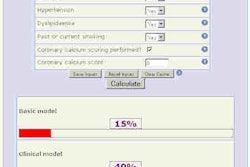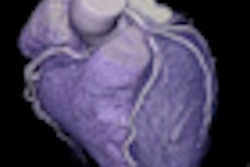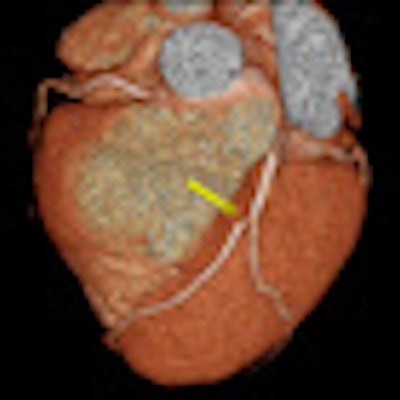
A majority of low-risk asymptomatic patients aged in their 50s demonstrate occult coronary artery disease at coronary CT angiography (CCTA), though very few are at imminent risk of death, concluded Spanish researchers in a presentation this month at the European Congress of Radiology (ECR).
In a study that broached the controversial topic of using a radiation-bearing CT scan to screen presumably healthy individuals for heart disease, the authors found atherosclerotic plaques in more than half of the 300 individuals they scanned with CCTA. Still, only a few suffered major cardiac events during a medium-term follow-up and none of these events were related to the presence of significant coronary artery stenosis, underscoring the difficulty of using CT to get a handle on patient outcomes in this population. Predicting who might be at risk of sudden death or major adverse events was a key goal of the investigators.
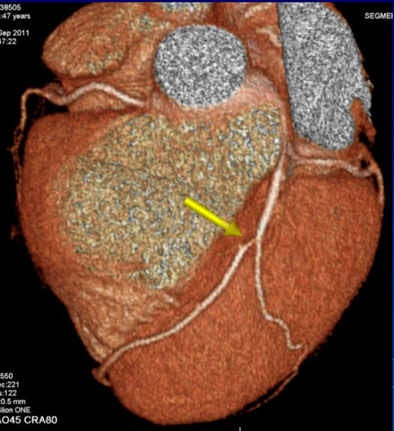 Above and below: In a 47-year-old asymptomatic woman who smoked five to 10 cigarettes per day, CCTA revealed a 74% stenosis (noncalcified plaque) in the proximal left anterior descending artery, with no other significant stenoses in the coronary vessels. In this case, risk stratification schemes would clearly underestimate the patient's cardiovascular risk, even considering her strong family history of having two first-degree relatives who suffered myocardial infarction before age 50, as genetic burden has not been well-studied in young patients. The effective radiation dose was 1.8 mSv. All images courtesy of Dr. Alberto Hidalgo.
Above and below: In a 47-year-old asymptomatic woman who smoked five to 10 cigarettes per day, CCTA revealed a 74% stenosis (noncalcified plaque) in the proximal left anterior descending artery, with no other significant stenoses in the coronary vessels. In this case, risk stratification schemes would clearly underestimate the patient's cardiovascular risk, even considering her strong family history of having two first-degree relatives who suffered myocardial infarction before age 50, as genetic burden has not been well-studied in young patients. The effective radiation dose was 1.8 mSv. All images courtesy of Dr. Alberto Hidalgo.
"A high proportion of patients with either sudden death or myocardial infarction don't present with previous symptoms," said Dr. Alberto Hidalgo from Barcelona's Hospital de la Santa Creu i Sant Pau. "However, risk stratification scales are known to underestimate the risk of coronary artery disease both in young people and in women; in risk stratification we have all these problems of intermediate or moderate risk so we need new markers."
Coronary artery calcium scoring has been used for risk assessment, but it's been shown to be a far better marker of intermediate than moderate risk, he said. But in recent years, CTA has emerged as a new tool for detecting occult coronary artery disease. A previous study showed that one-fourth of individuals tested had atherosclerotic disease despite the absence of symptoms, while those with normal CCTA results had excellent clinical outcomes.
"The purpose of our study was to evaluate the prevalence of occult coronary artery disease by CTA, to establish the relationship between the presence of traditional cardiovascular risk factors, and to estimate the impact of CTA in risk stratification," he said.
The research team included 310 asymptomatic individuals (87 men; mean age, 55 ± 9 years) without evidence of atherosclerotic disease, who underwent coronary CTA on either a 320-detector-row scanner (Aquilion One, Toshiba Medical Systems) (n = 202) or a 64-detector-row scanner (n = 108) as part of a general health screening exam. They were followed up for one to 7.5 years (mean 3.8 ± 2 years).
The cohort was not low-risk. "Most of the patients had mild or moderate obsesity, 75% of our patients were male, 50% had hyperlipidemia, and around 50% were smokers," Hidalgo said.
Characteristics of 310 patients scanned with CCTA
|
The results showed that 55% of the patients had atherosclerosis, 49% had no significant lesion, and more than 6% had significant lesions (> 70% luminal narrowing), he said. Age, male gender, diabetes, serum cholesterol, smoking, and hypertension were related to the presence of atherosclerosis.
Atherosclerosis risk factors
|
The patient group with atherosclerotic plaque had a greater median number of cardiovascular risks than those without plaque (2.1 ± 1.1 versus 1.2 ± 1, p = 0.0001).
As for stratification by risk factors, however, the previously validated Registre Gironí del cor (REGICOR) atherosclerosis risk algorithm classified most patients with coronary artery disease at CCTA as low-risk, Hidalgo said. According to REGICOR, "40% of the patients with coronary artery disease were classified as either very low (15%) or low (25%) risk," so REGICOR was not an independent predictor of cardiovascular disease, he said. Age and especially smoking were the leading risk factors for having coronary artery disease: There was an increase of 13% per year of age, while smoking quadrupled the risk of having coronary artery disease.
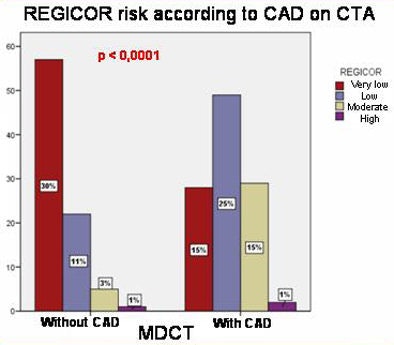 Forty percent of patients classified as low risk on the REGICOR risk scale had atherosclerotic plaque at MDCT.
Forty percent of patients classified as low risk on the REGICOR risk scale had atherosclerotic plaque at MDCT.As for major adverse events, there was one sudden death, one myocardial infarction requiring stent implantation, one percutaneous coronary intervention, two cases of unstable angina, and three cases of atypical chest pain -- and all these patients had nonobstructive atherosclerotic plaque at CTA. The results are in line with other data such as the Coronary CT Angiography Evaluation for Clinical Outcomes (CONFIRM) registry, in which patients with a nonobstructive lesion at CTA had higher mortality than patients with no plaque, Hidalgo said.
The patient who died, for example, was a smoker with moderate hypertension who had "a couple of plaques in the proximal [left anterior descending artery], but no significant lesions," he said. The cause of death was unknown, and perhaps not of cardiovascular origin, he added.
MDCT demonstrates a high prevalence of subclinical atherosclerosis in asymptomatic individuals who are at low risk (< 10%) on the REGICOR scale, the group concluded in an accompanying abstract. "The presence of coronary atherosclerotic disease at CTA correlates pretty well with the presence of traditional cardiovascular risk factors, and the midterm prognosis of individuals without coronary artery disease is excellent," Hidalgo said.
These study results are important because the screening of asymptomatic individuals with CCTA is highly controversial, commented session co-moderator Dr. Gudrun Feuchtner from Innsbruck Medical University in Austria, "and showing that 7% had significant stenosis is a strong argument for using CTA in asymptomatics," she said.





